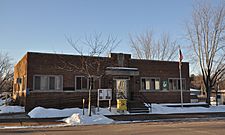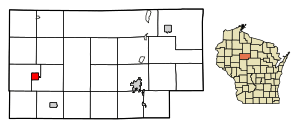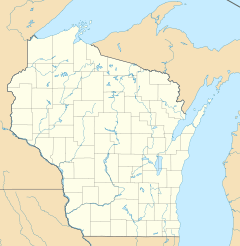Gilman, Taylor County, Wisconsin facts for kids
Quick facts for kids
Gilman
|
|
|---|---|
|
Village
|
|

Village of Gilman Municipal Building, February 2015.
|
|

Location of Gilman in Taylor County, Wisconsin.
|
|
| Country | |
| State | |
| County | Taylor |
| Area | |
| • Total | 2.34 sq mi (6.06 km2) |
| • Land | 2.34 sq mi (6.06 km2) |
| • Water | 0.00 sq mi (0.00 km2) |
| Elevation | 1,224 ft (373 m) |
| Population
(2010)
|
|
| • Total | 410 |
| • Estimate
(2019)
|
392 |
| • Density | 167.52/sq mi (64.67/km2) |
| Time zone | UTC-6 (Central (CST)) |
| • Summer (DST) | UTC-5 (CDT) |
| ZIP codes |
54433
|
| Area code(s) | 715 & 534 |
| FIPS code | 55-29175 |
| GNIS feature ID | 1583276 |
Gilman is a small village in Taylor County, Wisconsin, USA. In 2010, about 410 people lived there. It is located between the towns of Aurora and Ford.
Contents
Where is Gilman?
Gilman is in the southwest part of Taylor County. It's near where highways 64 and 73 meet. The Chequamegon–Nicolet National Forest is only three miles (about 5 km) to the east.
The village covers a total area of about 2.34 square miles (6.06 square kilometers). All of this area is land.
A Look at Gilman's Past
Gilman was not settled until 1902 or 1903. However, some people had already settled along the Yellow River nearby by 1900. By 1880, a "Winter Road" followed the Yellow River. This road went through the area that would become Gilman. It was used for logging operations further up the Yellow River.
How Gilman Started
In 1902 and 1903, the Stanley, Merrill and Phillips Railway built a railroad line. It crossed the Yellow River into the woods where Gilman now stands. The railway was heading towards Jump River and beyond.
The railway built a small house for its workers where the line crossed the river. They named this stop after Sally Gilman. She was the wife of the president of the Northwestern Lumber Company. This was the very beginning of Gilman.
Around 1905, another railway, the Wisconsin Central Railway, built its line. This line went northwest through Gilman. It connected Owen to Ladysmith and eventually Superior. This railway later became the Soo Line Railroad. Today, it is part of the Canadian National Railway line that still runs through the village.
Growing Fast
The village of Gilman grew quickly. A school was opened in 1904. The village was officially planned out in 1905. Soon, hotels, shops, a barber, and a post office opened.
In 1907, Roy Heagle and others started a mill called Gilman Manufacturing Company. It was on the south side of town near the river. This mill made barrels from local basswood trees. By 1912, it employed up to sixty men. During World War I, the mill worked day and night. It made barrels for ammunition. This mill operated until 1935. Heagle also ran other mills in Gilman.
Becoming a Village
Gilman officially became an incorporated village in 1914. By 1915, three gas lights lit the streets at night. These were the only street lights between Owen and Ladysmith at the time. That same year, the Catholic Church was formed. Other churches soon followed. A high school started in 1917.
In 1922, a big fire destroyed many of Gilman's businesses. But the community worked together and rebuilt the village.
A Nearby Village Declines
During the same time, the village of Polley had grown two miles (about 3 km) south of Gilman. Polley also had a school, a hotel, a store, a sawmill, and a newspaper. However, the Stanley, Merrill and Phillips Railway closed down in the 1930s. This caused Polley to decline. Today, only a few buildings remain there. Gilman, however, continued to survive and grow.
Modern Gilman
In the 1950s, a central high school was built in Gilman. It served all of western Taylor County. Since then, the elementary schools have also been brought together there.
Today, Gilman is smaller than it once was. But it still has a hardware store, cafes, a bank, and other services. The main employers in town are the school, a nursing home, and Gilman Cheese. Each year, the village hosts two major events: the Fall Fest and Snieg (Polish for snow) Fest in February. The Snieg Fest includes snow sculpting and a fun frying pan toss!
People in Gilman
| Historical population | |||
|---|---|---|---|
| Census | Pop. | %± | |
| 1920 | 522 | — | |
| 1930 | 414 | −20.7% | |
| 1940 | 440 | 6.3% | |
| 1950 | 402 | −8.6% | |
| 1960 | 379 | −5.7% | |
| 1970 | 328 | −13.5% | |
| 1980 | 436 | 32.9% | |
| 1990 | 412 | −5.5% | |
| 2000 | 474 | 15.0% | |
| 2010 | 410 | −13.5% | |
| 2019 (est.) | 392 | −4.4% | |
| U.S. Decennial Census | |||
Census Information from 2010
In 2010, the village of Gilman had 410 people living in 187 households. About 97 of these were families. The village had about 175 people per square mile (68 per square kilometer). There were 218 housing units in total.
Most of the people in Gilman (99.5%) were White. A very small number were from other backgrounds. About 0.5% of the population identified as Hispanic or Latino.
In the households, 23% had children under 18 living there. About 37% were married couples. Around 43% of all households were made up of individuals living alone. About 22.5% of people living alone were 65 years old or older. The average household size was 2.06 people. The average family size was 2.89 people.
The average age of people in the village was 47.8 years. About 21.7% of residents were under 18. About 27.3% were 65 years or older. The population was almost evenly split between males (49%) and females (51%).
Important Places
- The historic Gilman swinging bridge is a well-known landmark in the community.
Images for kids
See also
 In Spanish: Gilman (Wisconsin) para niños
In Spanish: Gilman (Wisconsin) para niños




